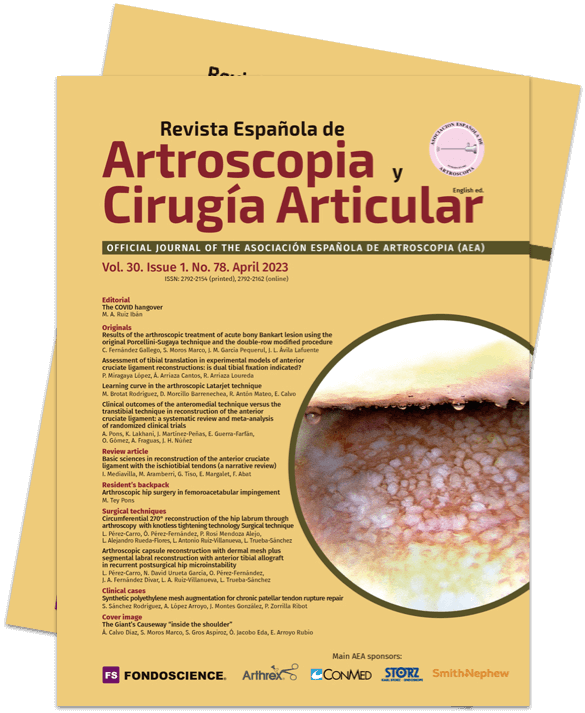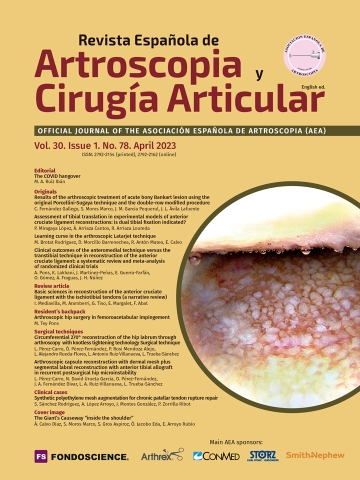Introduction
In the last few decades, growing importance has been placed on preservation surgery of the hip in young adults, due to a number of factors:
- Increased functional demand. The growing interest in sports and physical activity, seen as a path towards a healthy lifestyle and evidenced by the exponential increase in sport federation licenses, implies increased suffering of the joints(1,2). Furthermore, the improved quality of life of the population means that physical activity is prolonged in time, and that elderly individuals continue doing sports on a regular basis.
- Limits of prosthetic surgery. The incidence of prosthetic surgery, which constitutes the gold standard in the treatment of hip osteoarthritis(3) ― the disorder caused by the aforementioned overburdening of the joints ― is increasing in general, and in the population under 60 years of age in particular. Despite improvements in the metallurgy and tribology of prosthetic implants, the increased life expectancy of the population implies that this therapeutic option is not always definitive, and that implant replacements may be needed, with poorer functional outcomes and with an increase in patient morbidity. This is particularly important in the young population (under 50 years of age), where the outcomes are poorer, with lesser prosthetic survival indices in the different arthroplasty registries(4).
- Improved knowledge. Different studies indicate that hip osteoarthritis in the population under 60 years of age is of a known (and potentially treatable) cause in 95% of all cases(5). Among the different potential causes, mention must be made of metabolic disorders (rheumatic disease and synovial disorders), infections, tumours, vascular conditions (femoral head necrosis) and mechanical conditions. In this respect, mechanical conditions represent 70% of all known causes of hip osteoarthritis in the young adult. These are fundamentally post-traumatic disorders, mechanical stability conflicts (residual dysplasia of the adult) and mechanical spatial conflicts (femoroacetabular impingement).
- Development of new surgical procedures. Hip preservation surgery has developed in parallel with improvements in our knowledge of hip disease. The cornerstones of these new procedures are periacetabular osteotomy in hip dysplasia, and osteochondroplasty with chondrolabral repair for femoroacetabular impingement ― initially via open surgery and subsequently through arthroscopic surgery.
There is growing interest in scientific circles in this disease and its arthroscopic treatment. This has led to an exponential increase in publications in the last 15 years, as well as to the organisation of specific courses and the creation of scientific societies to address this topic. As a consequence of this growing interest, the Healthcare Technologies Evaluation Agency (Agencia de Evaluación de Tecnologías Sanitarias) of the Andalusian Health Service (Servicio Andaluz de Salud) considered it opportune to establish consensus on the usefulness and need to incorporate the mentioned technique to the Spanish healthcare system(6). The consensus reached was favourable to considering arthroscopic surgery in the management of femoroacetabular impingement of the hip.
The present study seeks to define and comment the main articles which all residents in training should know about hip preservation disorders and the arthroscopic techniques developed to treat them. However, it must be noted that behind all these articles lie other studies probably as relevant if not more so, and which have made it possible to advance our knowledge in this field. In the present study we will only mention those studies that summarise or are able to better express the fundamental concepts. The articles are not necessarily characterised by a high level of evidence, for although some present level of evidence 1, others are based on case series or reviews, or even on the opinions of authors ― with poor evidence if it were not for the scientific reputation of those signing the articles.
This summary of studies does not include articles on surgical techniques ― an area that is possibly less relevant and more changing over time due to progressive development of the different techniques. Instead, it focuses on solid concepts that explain, justify and warrant the use of hip arthroscopy in the treatment of femoroacetabular impingement. However, arthroscopists owe special recognition to Mark Philippon, who from Pittsburgh and subsequently Vail, established the principles of arthroscopic surgery for femoroacetabular impingement(7) and trained hundreds of surgeons ― some of which are mentioned in the present study.
The articles are not presented in chronological order or in order of importance or scientific relevance. The order is that which we believe can afford reasonable and orderly understanding of the important concepts for dealing with femoroacetabular impingement through hip arthroscopy.
Bouma et al., 2013(8)
Tom Hogervorst and Heinse Bouma are the authors of a number of publications on the morphology of the proximal third of the femur as an adaptive response to the environment. These studies of course are based on other previous works, including particularly those of Kappelman in 1988 and ultimately also Paul Bellugué in 1962, who described the two types of femoral head morphology found in humans. This comparative anatomical study, “Mammal hip morphology and function: coxa recta and coxa rotunda”(8), describes the adaptation to the environment resulting in the different femoral head morphologies in mammals. Coxa recta or sturdy hip, of limited sphericity and cervicocephalic offset, affords an adaptive advantage for mammals living on the open savannah and that require sturdy hindquarters with which to flee from predators or catch their own prey. At the other extreme we have coxa rotunda or agile hip, found in mammals that have evolved in the forest and require hindquarters suited for displacement in the undergrowth, for climbing trees or swimming in rivers. Coxa recta, found in approximately 30% of all humans, is characterised by asphericity of the femoral head, which we subsequently will refer to as cam type morphology, and is responsible for femoroacetabular impingement.
Hoffmann et al., 2003(5)
This is a simple review article in which Hoffman et al. developed the concepts and limits of preservation surgery. The article is not extensive and is probably not very original, but it does develop what they refer to as "the Stolzalpe school therapeutic approach", offering a very good definition of the causes of hip osteoarthritis in the young adult, as well as of the limits of preservation surgery and of the plastic adaptation possibilities of the different surgical treatments. The study, “Mechanical causes of osteoarthritis in young adults”(5), underscores the existence of a recognisable underlying cause in 95% of all patients under 55 years of age with coxarthrosis. These limits are of course variable and must be adapted to each moment and situation, and to the development of new surgical techniques, though the article is interesting and constitutes a good starting point for sensibly focusing the different therapeutic options.
Ganz et al., 2003(9)
Reinhold Ganz is undoubtedly an important reference in the history of modern hip surgery. In preservation surgery, he represented what John Charnley in his day represented in prosthetic surgery. The study published in 2003, “Femoroacetabular impingement: a cause for osteoarthritis of the hip”(9), explains femoroacetabular impingement as a potentially treatable cause of hip osteoarthritis, and its treatment through surgical luxation ― previously published by the same author ― constitutes an inflexion point from which hip preservation surgery is developed.
This work is a summary of other previous studies by the author and other members of the school from Bern, describing the biomechanical conflict referred to as femoroacetabular impingement, with its cam and pincer variants, as causes of the development of hip osteoarthritis. Likewise, femoral osteoplasty is described, in this case through safe luxation, as a treatment proposal for resolving the mentioned conflict and potentially avoiding the development of hip osteoarthritis. This is possibly the most widely cited article in hip preservation surgery, and from which the development of arthroscopic hip surgery also started.
Kelly et al., 2013(10)
Although the article is signed by Draovitch as first author, the concept of the analysis by layers to determine the origin of hip disease was established by Bryan Kelly, also from the Hospital for Special Surgery in New York. “The layer concept: utilisation in determining the pain generators, pathology and how structure determines treatment”(10) is a fundamental study in the differential diagnosis of coxalgia. It defines the different layers that potentially may cause pain in the hip: The osteochondral layer, which is usually dealt with by the orthopaedic surgeon, and which includes the current concepts of mechanical conflicts of space and stability. The capsuloligamentous layer, which includes damage to the acetabular labrum, the round ligament, and the controversial micro-instability or capsular instability of the hip. The musculotendinous layer, commonly ignored by the hip surgeon and only dealt with by the physiotherapist, and which also gains great importance from the works of Kelly on the concept of greater trochanter pain syndrome (GTPS)(11). The neurovascular layer, where we find sciatic nerve entrapment, the piriform syndrome, and all the disease conditions of the deep gluteal space, as types of pain commonly ignored by the orthopaedic surgeon, and which are concepts developed in detail in later publications by Hal Martin(12).
Martin et al., 2010(13)
Although signed by Hal Martin, this study involving the collaboration of a good number of pioneering surgeons in the development of the concepts of modern preservation surgery and arthroscopic techniques of the hip synthesises the 18 key points for correct physical examination of the hip. Together with the aforementioned article published by Kelly, “The pattern and technique in the clinical evaluation of the adult hip: the common physical examination tests of hip specialists“(13) establishes the principles for correct analysis in the differential diagnosis of hip disease in young adults. Although the study is methodologically poor, it establishes a consensus among a representative number of surgeons dedicated to preservation of the hip, with abundant studies that warrant its credibility and scientific level, and we feel that even though 10 years have gone by, it is still a perfectly valid reference in physical examination of the hip.
Griffin et al., 2018(14)
This is a multicentre study with level of evidence 1, published in The Lancet, and which confirms arthroscopic surgery of the hip in the management of femoroacetabular impingement as the best treatment choice. This study randomised 348 patients to arthroscopic surgery or a specific personalised physiotherapy protocol. Improved outcomes were recorded in the surgical group, with clinically and statistically significant differences in the quality of life outcomes at one year, based on the use of hip-specific questionnaires (33-question International Hip Outcome Tool, iHOT 33).
This is a methodologically excellent study of great value in that it provides scientific support for a technique that is often questioned in hip surgery circles. Few orthopaedic surgeons have been able to publish in journals such as The Lancet, and few surgical techniques are endorsed by studies with level of evidence 1. Thanks to Damian Griffin, arthroscopic surgery for the management of femoroacetabular impingement does have such endorsement. The study, "Hip arthroscopy versus best conservative care for the treatment of femoroacetabular impingement syndrome (UK FASHIoN): a multicentre randomised controlled trial"(14), has all the ingredients required of a study of this relevance: clinical trial, multicentre, good methodology, and randomised.
Conclusions
Arthroscopic hip surgery for resolving femoroacetabular impingement or conflict has solid scientific bases, with the support of consensuses coordinated by the health authorities (in addition to hundreds of published articles), and addresses a growing problem in our society. All residents in training should be aware of this situation, and all the healthcare regions in our country should be able to address and resolve this health problem.




